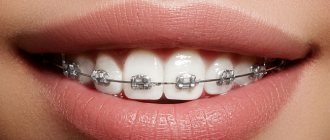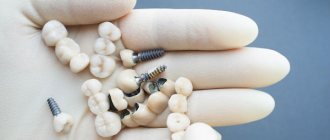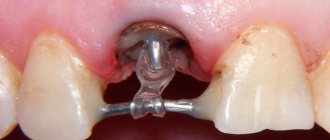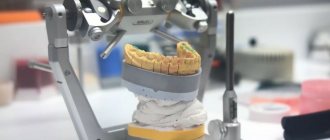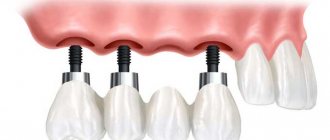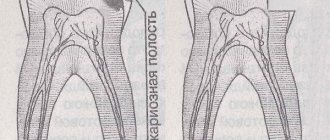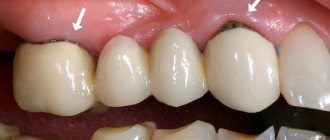21.11.2019
People who decide to restore their lost teeth often wonder which method is best to choose? The implantation procedure is the best option for those who do not want to suffer with removable dentures. But is it better to choose a pin or an Osteofit implant? In order to understand this issue, you need to know the difference between these designs.
Implant - what is it?
This is an artificial tooth root created in a laboratory. It is implanted into the bone tissue of a person’s jaw, after which a crown is installed on it, imitating the shape of the tooth. The installation procedure is quite complicated because surgery is required. These structures are installed when there are contraindications to pins, when it is not possible to preserve the tooth root. Implantation stages:
- Collection of primary anamnesis, examination of the patient.
- Selecting the model and shape of the implant, taking measurements.
- Manufacturing of the structure.
- Preparation for the operation.
- Implantation of the product into the bone tissue of the jaw.
- The rehabilitation procedure involves engrafting the structure and adapting the body to it.
- Installation of an artificial crown that will imitate a natural human tooth.
Manufacturing companies
Which manufacturing companies offer the best products? All prostheses can be divided into three categories depending on the price range:
- premium;
- mid-price;
- low priced.
What is the difference between these types? The difference between these implants is durability and wear resistance. The higher the price, the stronger the structure. The high-price segment includes products from the following companies:
- Nobel Biocare;
- Straumann;
- Astra Tech.
Nobel Biocare products are characterized by a high degree of integration of the material into bone tissue. The rejection rate is almost zero. The approximate price for one tooth ranges from 40,000 to 70,000 rubles.
The Swiss company Straumann gives an unlimited warranty on its products. The price for one implant is about 45,000 rubles. The Swedish company Astra Tech estimates its products at around 35,000 per implant.
The average price category of prostheses is less durable in use. Products in this category are represented by the following companies:
- Dentsply Friadent;
- Zimmer;
- Schlutz Dental;
- Rusimplant;
- MIS.
A distinctive feature of Dentsply Friadent products is the invisibility of the transition boundary between the crown and the rod. The price for one prosthesis is 35,000 rubles. The cost of products from the American company Zimmer ranges from 18,000 to 30,000 rubles. The price depends on the size of the implant.
The German company Schlutz Dental produces a variety of products at prices ranging from 20,000 to 30,000 rubles per implant. In the same price range are products from the Russian company Rusimplant and the Israeli company MIS.
In the low price range (7,000 - 17,000 rubles) there are products from Ukrainian, Belarusian and Russian manufacturers.
Advantages and disadvantages
Such designs have a number of positive and negative qualities that you should definitely know about before you think about installing them.
Among the advantages:
- product reliability;
- aesthetic appearance;
- durable and reliable structures;
- long service life due to the fact that the crown and the securing rod are a single whole;
- uniform distribution of load volume throughout the tooth.
Among the disadvantages:
- complex and lengthy implantation procedure;
- high cost of the operation;
- a large list of contraindications,
- required volume of bone tissue.
What is a pin?
If the tooth that requires intervention has broken off, but still has a healthy root , this can be used as the basis for restoration . To do this, the roots are carefully cleaned, depulpation is performed, and a pin is inserted into each cavity. This dental appliance is a thin metal or fiberglass rod. A crown is attached to it or a stable filling is formed. Thus, the pin most often becomes the basis that strengthens the extended tooth.
Advantages and disadvantages
Before choosing this method of teeth restoration, you need to understand the positive and negative qualities of this procedure.
The advantages are as follows:
- there is no need to remove the tooth root if it is in good condition;
- the cost is noticeably lower than that of an implant;
- the load is distributed along the entire length of the root;
- the design of the pin is noticeably thinner than the Nobel implant, which means there is no need for thorough cleaning of the tooth and the surface around it;
- during treatment you do not need to visit the doctor often, and this is an important plus - saving time;
- you can build up a stump under a ceramic crown.
Disadvantages in installing the structure:
- with strong pressure, deformation of the tooth root is possible;
- if there is no chemical connection between the root system and the crown, the structure will be short-lived;
- the remaining part of the damaged tooth will not last long, although it all depends on the characteristics of the organism.
There are cases when a doctor may refuse to install a pin:
- the presence of an old filling that will have to be removed;
- if the dentition is abnormally positioned, filling the canal may be difficult;
- incompletely cured granulomas, fistulas or cysts, which means filling the affected area is useless;
- the inability to extract inflamed areas of the dental canal if they are close to each other or if they are excessively curvature.
Comparison
The main difference between a pin and an implant is that the first dental component is installed in the root of the tooth - and therefore is classified as restorative, and the second is installed instead of the root - and therefore is considered denture. Thus, the pin is actually an auxiliary dental structure in the tooth structure. The implant is the leader.
However, they are obviously not complementary. The pin is not installed into the implant; the reverse procedure is completely technically impossible. But they can be considered interchangeable in many cases - from the point of view of the function associated with supporting the crown. That is, it can be supported by a root with a pin or by an implant.
But, in particular, only the pin performs the function of maintaining the filling. In the case of an implant, a filling in the traditional sense is not installed.
Pins are most often made of fiberglass, titanium or steel. Implants are usually titanium or zirconium.
Having determined what the difference is between a pin and an implant, we will record the conclusions in a small table.
How is a pin different from an implant?
The first ones are installed in the following cases:
- desire to preserve your tooth root;
- lack of a dental crown;
- the crown of the unit is destroyed by more than 50%;
- it is necessary to form a support when forming fixed and removable dentures.
How to prepare:
- Determining the degree of complexity of root destruction using x-rays.
- Depulpation of the dental unit.
- If necessary, filling the canals.
- Selection of materials and formation of design.
Installation steps:
- Using a drill, a hole is prepared in the bone tissue.
- The pin rod is screwed into the resulting hole.
- The upper part of the rod is used to restore the crown.
- The next day, the patient should visit the doctor again - when closing the jaws, the pin should not touch the tooth in the opposite row. If this happens, additional sanding will be required.
Installation of dental implants
Dental implantation is a relatively new technique that allows artificial roots to be implanted into the gums in the form of implants. After that, a crown or artificial tooth is placed on the base, which is practically no different in appearance from the real one.
There are two types of implantation according to the method and time of execution: one-stage and two-stage. One-stage dental implantation takes only 1-2 weeks and requires 2-4 visits to the dentist.
The decision to carry out one-stage implantation is made after tooth extraction; for this purpose, the hole is examined. A positive result is guaranteed if the removal operation is carried out carefully and atraumatically, and the surrounding tissue is not destroyed by inflammation.
Two-stage dental implantation involves installing all elements of the implant structure in stages. Let's look at these stages in more detail:
- Planning, panoramic images and testing. The preparatory stage is one of the most important when performing dental implantation.
The patient must pay increased attention to oral hygiene, since sterility is the key to a successful operation. In addition, at the stage of preparation for treatment, the jaw system is studied. A three-dimensional computed tomography scan of the jaw is performed to identify possible pathologies or contraindications to dental implantation. If necessary, sanitation of the oral cavity is carried out - removal of plaque and tartar, treatment or removal of teeth. - Surgical intervention At this stage, the bone bed is prepared for installation of implants.
To do this, an incision is made in the gum, it is separated, and a place is formed for a new artificial root. Then an implant is installed into the resulting bed, which is protected by a screw-in plug. This allows you to protect it from tissue ingrowth and food ingress. After installing the implant, the gums are sutured. - Implant engraftment process Complete engraftment requires from 1.5 to 6 months. If the operation is performed on the lower jaw, 2-3 months is enough, on the upper jaw - up to 6. A cosmetic tooth is temporarily placed during the implantation period.
- Installation of the “gum former” After the teeth have been implanted and the implant has healed, the gums are cut again and the “gum former” is installed.
It is necessary to create a base for an artificial tooth. The duration of its formation is 1–2 weeks. After removal of the former, when the implant has completely healed, an abutment is placed. It represents the link between the implant and the prosthesis. After a week, you can begin prosthetics. - The last stage: prosthetics. The orthopedic dentist makes impressions, manufactures and installs a crown on the implant. The main goal of this stage is the installation of a denture. Based on the principle of fixation of an artificial tooth, there are removable, combined, conditionally removable and fixed dentures. They are made by an orthopedic doctor using casts. The crown is installed on the implant.
With one-stage implantation, fewer surgical procedures are performed, a high cosmetic effect is achieved and gum plastic surgery is not required in the future (as with two-stage implantation). But with this technique there is a higher risk of complications, since it does not involve suturing the socket and isolating the implant.
Whatever type of implantation you choose, you need to understand that osseointegration (engraftment) of the implant takes the same time: 6 months for the upper jaw and 3 for the lower jaw.
Until the healing process is completed, full chewing loads cannot be applied to the implant, therefore permanent prosthetics in both cases is possible only after 3 or 6 months. Before this, in the one-stage method, an abutment connecting the part to the crown and a temporary crown are placed on the implant.
Despite the fact that with one-stage implantation the patient can immediately receive an aesthetic effect, two-stage dental implantation is used much more often, since it has a much smaller number of contraindications and a higher survival rate.
What is the difference between the designs?
The common purpose of both dental elements is to hold the crown that forms the tooth. In this regard, they are interchangeable, but not complementary, i.e. It is impossible to implant an implant into a pin, and a pin cannot be installed in the masonry. Otherwise, these components differ quite significantly from each other:
- The Astra Tech implant is a prosthesis that replaces a completely lost tooth, and the pin is an element for restoration, i.e. helps restore a partially lost element.
- The implants are made from zirconium and titanium, and the posts are made from fiberglass, but sometimes samples can be metal made from steel and titanium.
- An implant is an independent unit that is installed in place of a missing or removed root, and a pin is needed to hold the filling.
Now it is more clear what is better: a pin or an implant. However, when choosing a particular design, there is another determining factor - price. There is a big difference between them: implantation is always more expensive, because it looks more aesthetically pleasing and lasts longer. The cost of implantation directly depends on the region of residence and the prestige of the clinic where the installation is planned.
Category Implantation Published by Mister stomatolog
Pin or implant: what to choose
The decision to install a pin or prosthesis is made by the dentist , having carefully studied all the criteria in each specific situation:
- integrity of the root , its strength, absence of carious root destruction;
- the presence of indications and contraindications for performing a particular operation;
- individual characteristics of the patient’s jaw structure.
After assessing the condition of the affected tooth and the patient’s health, the doctor will help you choose the best option.
